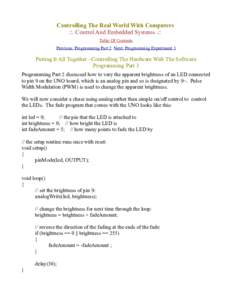 Date: 2016-02-02 18:33:32Software engineering C++ Computer programming Data types Light-emitting diode Signage Computing Const Sizeof Apparent magnitude C++ classes For loop | |  Controlling The Real World With Computers ::. Control And Embedded Systems .:: Table Of Contents Previous: Programming Part 2 Next: Programming Experiment 1 Putting It All Together - Controlling The Hardware With The So Controlling The Real World With Computers ::. Control And Embedded Systems .:: Table Of Contents Previous: Programming Part 2 Next: Programming Experiment 1 Putting It All Together - Controlling The Hardware With The So
Add to Reading ListSource URL: learn-c.comDownload Document from Source Website File Size: 118,18 KBShare Document on Facebook
|

